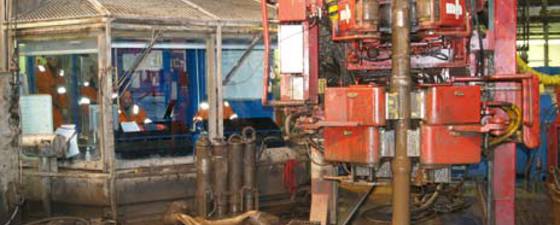Fractures occur naturally in the majority of rocks, and drilling through such fractured rocks can cause major challenges to wellbore stability that result in drilling problems. “This is because they have larger shear failure zones and smaller fracture gradient, fracture gradient being the pressure required to induce a fracture in a rock at a given depth,” says Jon Jincai Zhang, until recently Geomechanics Manager with Knowledge Systems, a company specialising in services to improve well planning and drilling, lately bought by Landmark Graphics.
Stability problems are expensive
“Lack of wellbore stability brings a reduction in the quality of well log records and consequently leads to difficulties in their interpretation. It also causes mechanical problems such as stuck pipes, high torque and back-reaming, instigating further dangers when setting the casing and removing cuttings,” Jon explains. “Using a heavier mud can help avoid these incidents, but the range of mud-weight we can apply in such fractured formations is narrow.”
“To solve this, we need to develop methods of accurately predicting the important features affecting stability: pore pressure, in-situ stress, shear failure and fracture gradient.”
“During drilling, stresses are redistributed, as rock is replaced with drilling fluid (mud), which can lead to either shear and tensile failure within a well,” Jon continues. “If the mud pressure is too low, the stress on the surrounding rock is too great, and shear failure, known as wellbore breakout, occurs, possibly leading to the collapse of the wellbore. On the other hand, if the wellbore mud pressure is too high, there is a danger of tensile failure, causing the wellbore to balloon, and leading to mud loss and lost circulation.”
“Variations in porosity are also a common feature of fractured formations, particularly carbonates. These lead to rapid changes in pore pressure, and compound the challenges in estimating mud-weights and fracture gradients in drilling.”
In the absence of any further information to guide them, wellsite engineers often use basic trial and error based on simple mud-weight correlations to nearby or analogue wells. They maintain this mud-weight until a failure is observed, at which point corrective action is taken – not necessarily the most cost-effective route.
The mud-weight window solution
Determining the safe mud-weight range is of critical importance to improving well planning and drilling for the oil and gas industry. To tackle the problems of predicting wellbore stability, Jon considered the effects of both fractures and porous formations, and from this developed a ‘double porosity model’ so drillers will have a better idea of what to expect before they start working on a particular well.
“We established the model using known variables such as rock strength, pore pressure profile, and in-situ stress from well log data,” Jon explains. “We then used finite-element analysis to obtain a wellbore stability solution.”
“Our model was successfully tested in a case study in Oman, where we performed pre-drill analysis for pore pressure and wellbore stability, and then sent a pore pressure engineer to do real time model updates during drilling. The well encountered both weak claystones, which could cause well collapse, and heterogeneous and fractured carbonates with a low fracture gradient, which could potentially cause mud losses during drilling. When limestones and claystones are drilled in one casing interval, the mud-weight window is very narrow, as too high a mud-weight risks fracturing and drilling fluid losses, while a lower mud-weight induces wellbore breakouts or collapse. Additionally, some of the gas-bearing formations in the Omani well have very high pore pressure, which could cause kicks and blowouts, making drilling more risky. It was therefore imperative that the model predicted the correct mud-weights to avoid well failure,” John emphasises. “We were happy to find that our model accurately predicted the range of mud-weights needed to drill the well with the least risk.
A similar pre-drill pore pressure and wellbore stability analysis project was successfully conducted in the Western Zagros foothills in Iraq.
“The geomechanical analysis combines wellbore parameters, such as inclination, azimuth and hole size, with rock properties, so as to develop a specific solution for each section of the wellbore. It is cost-effective, because predictions for multiple wells can be made from a single model.”
“Another advantage of the method is that if we prepare an accurate model before drilling, it is possible to react rapidly in real time as a well is being drilled,” Jon concludes. “Mud-weights and casing parameters can be altered in-situ to ensure successful drilling.
A New Field of Study
“I have found working in this area very exciting,” Jon says. “Studying wellbore stability in fractured rocks is a new field, and calculating the fluid properties required is very challenging. Ultimately, we are helping the oil and gas industry to understand and predict pore pressure and wellbore geomechanics, so that wells can be drilled and produced as safely and economically as possible.”






